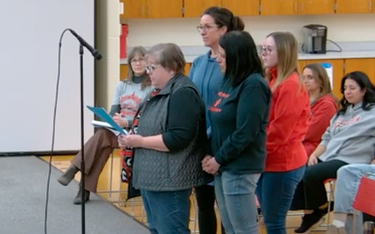GCSD proposes $128M budget, $57M capital project
GUILDERLAND — Three weeks later than planned, on March 25, the school board here was presented with a draft of a $128 million budget for next year.
Voters will have their say on May 20 at which time they will also vote on a $57 million capital project, which district leaders have described as making the schools future-ready — upgrading all seven schools and adding to the high school; $4.5 million of that cost is being covered by a capital reserve fund.
Administrators spent the added three weeks on the budget, Assistant Superintendent for Business Andrew Van Alstyne said on March 25, going through the spending plan with a fine-tooth comb, trying to find savings.
For the first time since the cuts brought on by the Great Recession, the school board heard myriad comments — both written and in person — protesting cuts. Parents, teachers, teaching assistants, and students shared their views.
At the March 25 session, the board heard from nine people in person and received another 25 written comments with one hand-written letter signed by 21 grade-school students.
“TAs are helpful because when you need help they help you but don’t give the answer,” the letter said.
Most of the comments were to oppose cutting the first-grade teaching assistants and to oppose reducing class sections — particularly at Altamont Elementary’s fourth grade — making larger classes.
In the end, the draft budget restored 70 percent of the first-grade teaching assistants, to be drawn from a pool based on need. It also restored two-tenths of a librarian’s position at Altamont Elementary School, another cut that had spurred protests from a committed Altamont contingent.
In December, Van Alstyne had projected a rollover budget — keeping all programs and services the same — of $130 million for Guilderland next year, an increase of 4 percent over this year.
The health-insurance increase alone, of $2.3 million, is more than the allowable levy increase, of $1.8 million.
Guilderland had drained the reserves it had set aside to cover the many tax challenges filed by property owners after the town’s revaluation and so took out a bond to cover the costs, with payments totalling $747,000 overall.
The finalized draft is for $127,560,142, an increase of about $2.4 million, or 1.89 percent, over this year’s budget.
The budget draws $166,685 from its fund balance and $120,000 from its reserves.
The lion’s share of the expenses are covered by property taxes and the draft budget calls for the maximum levy increase allowed by the state — $1,832,602 — without going over the tax cap.
This means the budget would need a simple majority vote to pass on May 20 rather than a supermajority — more than 60 percent — if the tax cap were pierced.
While the proposed levy increase is 2.22 percent, the estimated tax increase is 1.53 percent because, Van Alstyne explained, of rising property values.
“We’re trying to strike a balance …,” said Superintendent Marie Wiles. “We hear loud and clear that people want us to find a way to hang on to our first-grade TAs.”
Wiles had said earlier that eight teaching assistants were retiring so, while the posts would be cut, no one was losing a job.
The goal, she said on March 25, is not to put the district in a place in the future where “we’re not just losing positions by attrition but we’re laying people off.”
Several board members asked about using more of the district’s fund balance, or rainy-day account, to keep more teaching assistants or smaller class sizes.
Van Alstyne advocated keeping money in reserve — up to 4 percent of the next year’s budget is allowed by state law — for flexibility in an emergency.
He showed a chart and a graph that illustrated how schools had managed the Great Recession and also showed a graph illustrating how Guilderland lags behind its Suburban Council peers in the amount of its fund balance.
Van Alstyne also referenced the “fiscal cliff” the district would be faced with if it used emergency rainy-day funds for recurring expenses. Further, he noted that Guilderland’s rating from the state comptroller as being susceptible to fiscal stress, since rectified, had hurt its credit rating, causing added expenses for borrowing.
Wiles referenced comments made earlier in the meeting by Assemblyman Phil Steck about how federal cuts to, for example, Medicaid, could well have an effect on New York’s school funding.
Wiles said, “There’s just a lot of uncertainty … This would be a time to have more in savings rather than less.”
Wiles noted that “$1.9 million of our staff are paid for by federal dollars,” money that is part of the budget draft.
“These are all people who have positions working with students with disabilities and our ENL [English as a New Language] students … and, should those resources go away, “ she said, the district would have to use its rainy-day account.
In the proposed 2025-26 budget, 4 percent unassigned fund balance would be $5,101,715 . To maintain 4 percent, Van Alstyne said, the district will need $94,002 in surplus from this year.
Wiles suggested that Guilderland, like other schools, could be entering a period similar to that during the Great Recession, when the district had to cut almost 230 staff members.
“It was dreadful,”she said. “We had long seniority lists and we had many terrible meetings with people to say, ‘I’m so sorry, but you’re going on an appeal list.’ And we do not want to do that. We value our people very much. We want to keep them whole.”
Wiles concluded of the budget draft, “So this is not ideal.”
She went on, “It’s a very difficult year and we’re not used to this. We have had years with federal dollars flowing where the answer to everything was ‘yes.’ We’re not there any more.”
The board is slated to adopt the budget at its next meeting, on April 8. Although the state budget is due by April 1, the legislature and governor are not expected to come to an agreement by that date.
However, Van Alstyne has noted that the governor’s proposal, the more conservative estimate on which Guilderland’s budget is based, had already increased Guilderland’s Foundation Aid by nearly 6 percent and he surmised that Guilderland is unlikely to get more in the final state budget.
Last year, the school board adopted Guilderland’s budget before the late state budget had been finalized. The district ended up receiving $98,000 more in state aid than the conservative estimate on which the budget was based. Since the district could not then spend those added funds, they were put in reserves.
Petitions for board candidates to run for four seats are due on April 21, with at least 43 signatures.
The board has nine members and the posts, typically with three-year terms, are unpaid.
Three out of four Guilderland School Board incumbents — Meredith Brière, Katie DiPierro, and Kelly Person — are planning to run for re-election on May 20.
Gloria Towle-Hilt has decided to retire after serving for 18 years on the board.
Other business
In other business at their March 25 meeting, Guilderland School Board members:
— Applauded Guilderland High School physical-education teacher Tamara Bryngelson-Eppard who has been named the New York State Association for Health, Physical Education, Recreation and Dance Capital Zone’s Secondary Physical Education Teacher of the Year for 2025.
Allison Relyea, a sister teacher, said Bryngelson-Eppard teaches her students “to be responsible, respectful members of the P.E. class and society as a whole”;
— Heard from Assistant Superintendent for Curriculum and Instruction Rachel Anderson who was applauded for receiving tenue, that a brass quintet — YoonSoo “Sam” Woo on trumpet, Toby Weiss also on trumpet, Anthony Padula on French horn, Brendon Cao on trombone, and Ian Dunn on tuba — will perform at Lincoln Center on May 8.
Anderson also reported that seven students performed at the New York State Band Directors Association Annual Symposium in Statewide Honor Bands; from Farnsworth Middle School: Andrew Padula, Emma Padula, Kriti Siddi, Aleesa Sikkander, and Daniel Woo and from Guilderland High School: Adam Hawrylchak and Anthony Padula.
Finally, Anderson reported that 12th-grader Siyi Guo won a contest so that her composition, “ “Rose-colored Glasses and Hatred-filled Eyes,” will be performed by the Empire State Youth Orchestra on June 1 at The Festival of Young Artists at the Saratoga Performing Arts Center;
— Voted unanimously to send back to the board’s Business Practices Committee the calculations for granting tax breaks to low-income senior citizens and low-income disabled district residents.
Van Alstyne said he has had “multiple phone calls” about it and so talked to the town, which had also granted tax breaks.
“I was under the impression that our calculations aligned,” Van Alstyne told the board but that turned out not to be the case;
— Approved the Marie Wiles Scholarship in honor of the superintendent who is retiring in June. The scholarship is to “recognize a student who has worked to make others feel a part of the community, has been a member of Best Buddies, Unified Sports, Unified Physical Education, or has helped support students who are learning English as a New Language.”
Wiles said she was “so touched” by the PTA Council-sponsored scholarship.
“It captures your essence and I think that’s a really beautiful thing,” said board President Blanca Gonzalez-Parker;
— Adopted updated policies on student harassment and bullying prevention and intervention, school district records and access to them, acceptable use of computers and the internet, elementary attendance, and school safety plans; and
— Met in executive session, as allowed by law, to privately discuss contract negotiation updates with the Guilderland Teachers’ Association, Teaching Assistants, Guilderland Office Workers Association, Principals, Guilderland Support Staff Association, Instructional Administrators, and Technology Personnel; the employment history of particular persons and matters leading to tenure appointments; and issues relating to potential litigation.



